DIY rose arches - an entrance to a blooming paradise
Any garden is decorated with lush and bright bushes of flowers, scattered like artist's strokes throughout the site. They bring harmony and comfort. The most beautiful and unusual decor is considered to be arches entwined with roses or other climbing plants. These structures are installed at the entrances to the garden or divide the territory into small conventional areas.
In summer, trellises or arches entwined with roses create a spectacle of unearthly beauty. The site is being transformed, a real fairy tale is being created. Making arches for roses is not difficult. Moreover, they are a necessary element for growing climbing rose... The shoots of the beauty must cling to something, they need to be helped to grow and trail. Without this, it will not be possible to grow a luxurious climbing rose bush. This quick guide will help a florist build arches for roses with his own hands, learn about the types of supports and what they can be made of. Installation of the arch and proper care of the climbing rose is a guarantee of the amazing beauty of the spectacle in the summer.
Content:
- Arches for roses: benefits
- Arch shapes
- Arches material
- Do-it-yourself arch
- Growing and caring for a rose on an arch
- Correct planting of roses and reproduction
- The nuances of attaching branches to transverse battens
Arches for roses: benefits
With the help of arches, the florist creates coziness in the garden. They are often used to divide an area into zones. For example, a part of the territory where vegetables grow is separated by trellises and an arch between them from the area with flowers or fruit trees.
Many people build arches to create a resting place. In the resulting space, benches with a small table are installed. This is how a summer gazebo is obtained, shaded and fragrant. roses... In large areas, a whole series of arches are erected, following one after the other - an alley. In summer, such a structure is covered with dense green roses and gorgeous flowers. The sight is incomparable. The uses and benefits of arches are many.
The fantasy of a florist can roam, since it is not difficult to build such a support for roses, it does not require large costs and special skills.
Another indisputable advantage is helping the rose grow. Without any support, the plant will lie on the ground, bloom and grow poorly. It must be tied to the supports of the arch, to guide its growth and branching. It's necessary. The presence of an arch greatly simplifies care for roses and helps them to develop correctly, in a timely manner.
Every florist dreams of a beautiful and elegant garden look. In this he will be helped by special constructions and impeccable flower queens.
Arch shapes
The shape of the arches can be different. It depends on its purpose, location and the type of roses themselves.
- The most common and popular type is considered to be an arc-shaped arch made of metal rods. It is usually installed on flower bedsframing its area. It gives the impression of a basket entwined with roses and filled with different types of flowers. Its device includes two rods as a base, the arc itself, and several small transverse cuts. They serve as a support for the branches of roses, and shoots cling to them.On sale you can find such arches with a special locking element. That is, the arch can be disassembled for the winter, which is very convenient. It is laid on the ground, this allows the gardener not to suffer in the fall with the separation of roses from the structure. The plant, together with the structure, is closed for the winter, and in the spring the arch is raised again.
- Wooden structures are also very popular. They look very impressive and natural. The arch has the form of a rectangular shape - the entrance, entwined with flowers. This form is used when entering a house or gazebo... Here, the base pillars are dug into the ground, between them transverse slats are installed for fastening the branches. The top of the arch can look like a visor or grille. Typically, such an arch connects a living fence or trellises for roses.
Whichever form the gardener chooses, it will in any case decorate the site. Vertical structures add completeness to the garden and visually increase the area.
Arches material
The only requirement for a material is its strength. The structure must support the weight of the bush:
- The favorite material of florists and landscape designers is wood. It looks very natural and lasts a long time. Before making an arch from wood, all elements must be covered with an antiseptic. Further, wooden slats and pillars are opened with varnish or painted over with paint. This is done so that the plant does not pick up disease or a parasite from an untreated tree.
- Many people build supports in the form of an arc made of metal. Reinforcement is often used. This material is reliable, durable, and easy to work with. The material is also processed with paint. It is necessary to monitor the appearance of rust. It should not be, as it can significantly damage the delicate rose.
- On sale you can find arches made of plastic. These structures do not require additional coatings. Often plastic structures are accompanied by locking elements, they are easy to assemble and move around the site.
- Materials can be combined, combined. For example, many flower growers use metal as pillars, and the transverse slats are made of wood. They also use stone as the main material, but it is better to entrust such a structure to specialists, since it requires some skills for installation.
Do-it-yourself arch
In order to make a support with your own hands, you need to decide on its purpose. Will it only serve as a decoration on the flowerbed or will it be an entrance, a place to rest. The purpose is taken into account when choosing the material and thickness of the bases, cross battens.
To make a metal arch, you must:
- Have rods with a diameter of about 0.6 cm. Typically, 2 rods are used as a base. They are given the shape of an arc and then dug into the ground to a depth of 50 cm.
- Between the main rods, metal rods are fixed to fasten the plant. They can be welded or secured with wire.
- Always consider this point - in the fall, the plant will need to be removed from the structure. This is not easy work. Therefore, it will be better if the crossbars are fixed to the wire. Thus, they can be simply removed and pulled out of the branches of the plant.
- The process of removing a rose from an arch will be much easier. Metal elements should be painted over before installation.
For a wooden arch, you will need six beams of different lengths. In four of them, it is necessary to drill holes for further fastening of the cross rails in them. The length of the beams, the bases, may vary depending on the purpose of the arch. If it serves as an entrance to the house, then the length of the base beams should be at least two meters. The two bars are interconnected by transverse slats.
It turns out the so-called ladder. Two such ladders need to be made. Then they are dug into the ground. The top of the arch is closed with smaller beams. Consider factors such as wind and storms when setting up the foundations. The design must be able to withstand them.
All wooden elements can be opened with varnish or paint.
When installing structures, always consider not only their purpose, but also variety of roses... Heavy and large species require more durable structures and vice versa.
Growing and caring for a rose on an arch
Florists advise choosing Rambler roses for the arch. Their shoots bend very well, and the bush itself can grow up to three to four meters in height. The flowers of these beauties are often small, but gathered in bunches, which makes the lash bright and luxuriantly blooming. According to gardeners, only this species is able to give the desired result - a completely entwined arch with a carpet of fragrant flowers. However, there is also a small disadvantage of this type - a one-time bloom... But to date, breeders have managed to breed varieties of this species with multiple flowering.
A lush blooming rose bush is guaranteed with proper plant care. In the summer, you need to monitor:
- Regular watering roses
- Top dressing
- The emergence of weeds
- Trimming and the direction of the shoots
It is very important to weed the roses at the time. Try to avoid overgrowing the bush with weeds. The first feeding with nitrogen fertilizers is carried out in the spring after trimming... Further, the rose is fertilized with complex mineral preparations every three weeks during the growing season.
Closer to autumn watering and top dressing stop. The plant is preparing for winter. In the fall, the rose is lowered to the ground and covered with non-woven materials. The soil under the rose must be dry. At the end of summer, the plant is already fed with phosphorus-potassium fertilizers.
Remember that an excess of any fertilizer can provoke the appearance of rose diseases.
In the first year of growing the plant, feeding is minimized - twice a season, in spring and in mid-summer. For a climbing rose, sunny and moderately damp areas are suitable. Try to install the arch in a location protected from the wind. These simple maintenance rules will help you grow a large and luxurious rose bush for your arch.
Correct planting of roses and reproduction
By planning landing climbing roses, you need to remember some rules:
- The most important of these is the distance between the bushes. The splendor of the bush and the degree of coverage of the arch itself will depend on this. The optimal distance is one meter.
- Roses are planted in early spring. For each bush, a pit is formed with dimensions of about 40x40 cm, depending on the variety. Plants do not require special soil conditions; ordinary garden soil is suitable for a climbing rose.
- Immediately after planting the bush in the soil, the plant should be fed with nitrogen fertilizer.
- Further, in the summer, they use complex mineral fertilizers.
Climbing roses can be propagated using cuttings or dividing the bush... It is better to do this when the main bush, which is planned to be propagated, has already gained strength and has been living on the site for at least two years.
Proper planting, respecting the distance between the bushes, will allow the grower to grow a luxurious, fragrant rose bush on the arch.
The nuances of attaching branches to transverse slats
As the bush grows, the rose shoots are attached to the slats obliquely, and not clearly vertically. This will allow the bush to stretch not only straight up, but also in width. Form the bush throughout the growing season, otherwise the branches will only weave upward, and not across the entire width of the arch. Rambler roses are very easy to shape, their lashes are flexible.
It is important to constantly monitor the growth of the shoots and, during them, attach them diagonally to the arch slats.
The climbing rose on the arch is an amazingly beautiful sight. It is not difficult to build a structure and grow a luxurious rose bush if the basic rules for leaving behind the plant and the installation of the arch itself. The only thing a florist needs to do is to be patient, as an arch entwined with roses takes time to grow. Already in the second year, the plant will delight the lover of beauty with its elegance and bright, lush flowers.
More information can be found in the video.



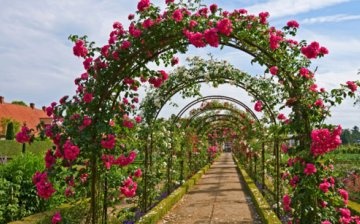
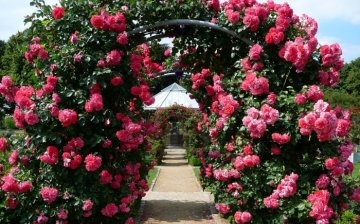
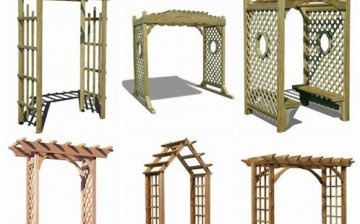
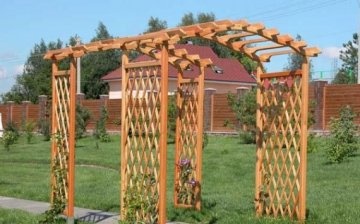
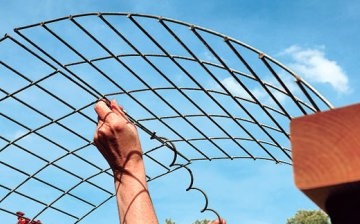


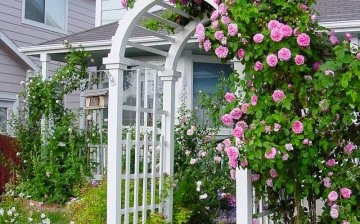










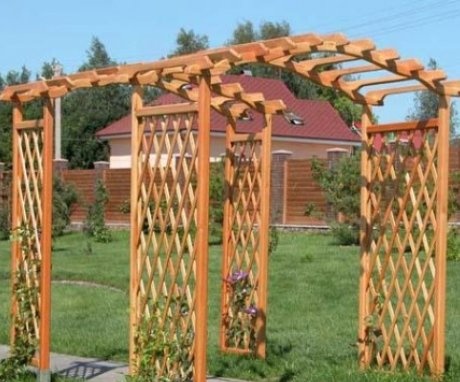

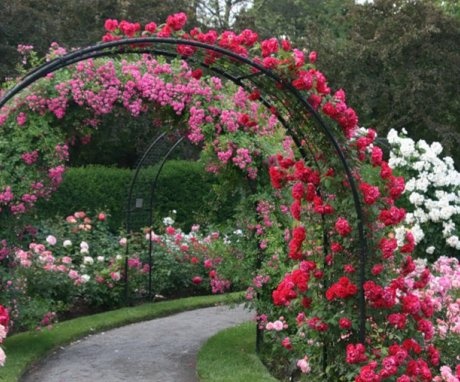
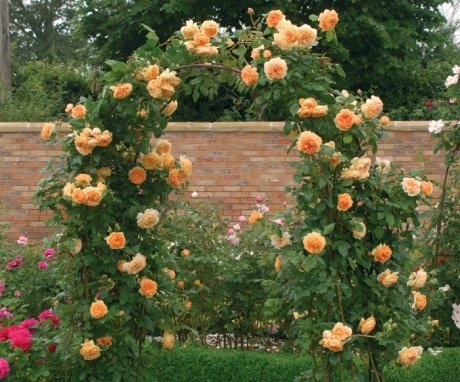
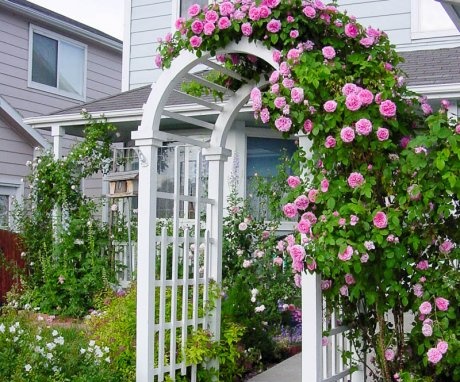
The main thing here is imagination and everything will work out for you, you can use any available means. Even I made a small arch in the garden, it turned out like nothing, I really don't know how long this arch will last me.
We made an arch for roses from a plastic pipe, but the diameter of the pipe was initially small. The design turned out to be flimsy. The second time they took a polypropylene pipe one and a half times thicker. It turned out well.